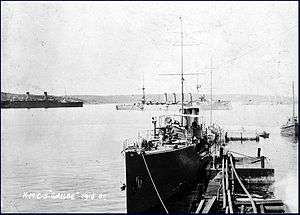HMCS Grilse
- For the Canadian submarine named HMCS Grilse, see HMCS Grilse (SS 71)
 HMCS Grilse (foreground) in 1916. The ship's forward 12-pounder gun and open bridge are clearly visible. | |
| History | |
|---|---|
| Name: | Grilse |
| Namesake: | Atlantic salmon |
| Builder: | Yarrow & Co., Glasgow |
| Launched: | 1912 |
| Commissioned: | 1915 |
| Decommissioned: | 10 December 1918 |
| Fate: | sold 1922 renamed Trillora, foundered 1938 |
| General characteristics | |
| Displacement: | 287 tons |
| Length: | 202.3 ft (61.7 m) |
| Beam: | 18.3 ft (5.6 m) |
| Draught: | 9.2 ft (2.8 m) |
| Speed: | 30 kn (56 km/h; 35 mph) |
| Complement: | 56 |
| Armament: |
|
HMCS Grilse was a commissioned patrol boat of the Royal Canadian Navy (RCN) during the First World War. She was originally a private yacht named Winchester until her purchase by the RCN after the outbreak of war. Grilse's name is a pseudonym for Atlantic salmon. After the war she was sold back to private interests.
Service history
Prewar service
The vessel was built as the high-speed civilian yacht Winchester by Peter W. Rouss, who was born in Winchester, Virginia. She was built along the lines of a torpedo-boat destroyer with twin funnels, a low hull and a raised forecastle which extended back to form a compass platform over the saloon. The tall mast was placed amidships. She was comparable in size to an E-class destroyer from 1901–1904, however Winchester was considered faster due to her turbine engines.[1]
Service with the Royal Canadian Navy
In 1915, Canadian industrialist and millionaire Jack Ross purchased Winchester for $100,000. At the time, an embargo was in place preventing the sale of any ship to belligerents in the war. The American government discovered the sale and attempted to block the transaction, but Ross managed to get out of the country with the ship.[1] Ross was later reimbursed by the federal government.[2]
After arrival in Halifax it was arranged for her conversion for military use. The ship was armed with two 12-pounder guns, one fore, placed on the forecastle and one aft, placed on the quarterdeck. A 14-inch (356 mm) torpedo tube was sited amidships. The aft deckhouse was removed to make room for the torpedo tube and the three torpedoes that were to be carried on deck. The mast was moved forward to directly behind the bridge and a second mast was installed to give the vessel a horizontal antenna to improve radio communications. There were also some alterations to the crew quarters to make room for the larger number required in a warship.[1]
Grilse was commissioned as a torpedo boat and operated off Canada's east coast for much of the war. Her intended use as the most powerful Canadian warship on the east coast following the laying up of the cruiser HMCS Niobe, was as the primary offensive unit to any sighting of enemy ships.[1] Spending the better part of her service with the Halifax patrol, she was loaned to the Gulf patrol in September 1915 and operated as a ship escort in the Gulf of St. Lawrence.[3] The vessel was eventually withdrawn from inspection duties along the coast due to the high cost of use and was relegated to patrol duties only.[4]
Unsuitable for winter operations in Canadian waters, Grilse was sent to the Caribbean Sea during the winter months. In 1915, she was sent to Jamaica. In December 1916 the ship was sent to join the North America and West Indies Station, but encountered a heavy storm on the way and nearly sank. Headquarters actually believed the ship destroyed after they lost communications with Grilse (her antenna had been lost in the storm) and sent out vessels to search for wreckage. However, Grilse had managed to make it back to Shelburne. She was then towed to Halifax for a refit.[5] The ship re-entered service on 10 May 1917[5] and was used as a patrol ship until August later that year when she returned to the dockyard to undergo repairs. She returned to escort and patrol duty until the end of the war. Grilse was paid off on 10 December 1918.[6]
Postwar service
Attempts to sell Grilse as surplus in 1920 were unsuccessful, and she was used for training purposes in 1921-22 before being sold to Solomon Guggenheim in 1922. Renamed Trillora, the ship was still in Guggenheim's ownership when she foundered at Long Island in the New England Hurricane of 1938.[7][8]
The name Grilse was subsequently used for a sail training yacht and later a submarine, HMCS Grilse (SS 71).
References
Notes
Sources
- Johnston, William; Rawling, William G.P.; Gimblett, Richard H.; MacFarlane, John (2011). The Seabound Coast: The Official History of the Royal Canadian Navy 1867-1939. 1. Dundurn Press. ISBN 1554889073.
- Macpherson, Ken; Barrie, Ron (2002). The Ships of Canada's Naval Forces, 1910-2002 (3 ed.). St. Catharines: Vanwell Publishing Limited. ISBN 1551250721.
- Milner, Marc (1999). Canada's Navy: The First Century. Toronto: University of Toronto Press. ISBN 0-8020-4281-3.
- Tucker, Gibert Norman (1952). The Naval Service of Canada: Volume I: Origins and Early Years. Ottawa: King's Printer.
External links
- Converted civilian vessels
- Canadian Navy Heritage Project: Ship Technical Information
- Canadian Navy Heritage Project: Photo Archive